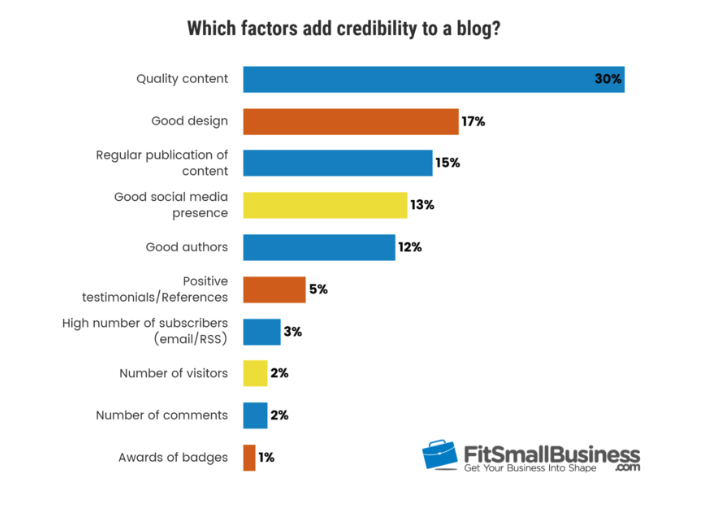“I clicked ‘publish’ and everyone flocked to my site!” said nobody ever. So, you’re convinced that a blog can help grow your brand. While there’s a good chance that can happen, there are a few things you should know before you start cranking on your first post.
Share on facebook
Share on twitter
Share on linkedin
Share on facebook
Share on twitter
Share on linkedin
There are countless branded blogs all across the web. The company blog has become table stakes, something that consumers expect to see. It's a place for the brand to showcase expertise, build trust, and generally promote a brand's paradigm to prospects, customers, investors, and potential employees. However, it's harder than ever to break through and capture attention.
"I clicked ‘publish’ and everyone flocked to my site!”
–Nobody ever
Blogging is like exercising at the gym: you can’t just show up, go through the motions and expect to see the results you want. Much like fitness, getting the outcome you desire takes time, effort and maybe even some help from an expert.
And just like fitness, a lack of investment is why many company blogs don't live up to their true potential. Either there's an underinvestment upfront, or the blog starts off strong only to fade away as priorities inevitably shift. Life happens, and blogging ceases. So, if you want to nurture an active company blog, there are two basic factors that drive success: quantity and quality.
Quantity
Visiting a brand’s website only to find that the last blog update was eight months ago can be a red flag for prospects. It can signal either a company in distress or a company that can't follow through. Sparse content doesn’t just create a reputation problem, it creates an SEO problem too. Recency is a factor in ranking both for better brand perception and higher search engine rankings.
After dissecting blog data from more than 13,500 websites, HubSpot found that companies that published 16 or more blog posts per month saw about 4.5 times as many leads compared to companies that published fewer than four monthly posts.

One brand that thrives thanks to consistent publishing is GoDaddy. From web hosting to email to domain names, GoDaddy has thousands of blog posts in its “Garage.” The posts are even custom-made and categorized for specific industries. After all, building a website as a lawyer is a lot different than building a website as a wellness spa owner. No wonder GoDaddy is the world’s largest domain registrar!
When deciding how often to publish, be realistic. Once you set a cadence, it's important to keep maintaining it. And we know how hard that is -- just look at our own blog to see how things can slip when committing to a set number of articles each month!
Quality
Churning out blog posts every day isn’t a magic solution for generating leads and earning trust. The second, and arguably the most important, part of the content creation equation is quality.

It's more effective to post fewer high-quality articles rather than churning out crappy content just to fill a quota.
Quality builds credibility.
The definition of quality can vary depending on the reader and the industry; it’s one of those you-know-it-when-you-see-it things. If there’s one overarching theme across all high-quality blogs, it’s the value they add to the reader’s life. This value happens through one or more of the following article types:
- A fresh perspective that connects ideas in a new or novel way.
- A data-driven piece that uses proprietary statistics to showcase the company's unique perspective.
- An analysis that reveals something about the way the company sees the world -- and how this impacts the reader.
- A comprehensive resource that curates a variety of perspectives into one central reference.
- A revealing interview with someone smart: industry leaders, executives, employees, and customers are all potential mines of information.
Case in point: Acorns
Consider Acorns, the app that automatically invests your spare change. Acorns invests in its own digital magazine called Grow, yet the writers don’t annoy their audience by promoting the parent company. In fact, a command+F search for “Acorns” won’t yield any results in most of the articles. Instead, the writers share practical money management content such as “How Much Should You Spend on an Engagement Ring?” and “8 Moves That Can Net You an Extra $550 Per Month.”
As a result, Grow has accumulated 3,500 followers on Twitter in its own right. Meanwhile, Acorns is evolving into a full-fledged financial institution with 3.8 million users and more than $1 billion under management.
When it comes to content, audiences today don’t have the patience for brands that are selfish, lazy, or both.
“It's not just enough to post photos of your product and tell your Facebook followers how amazing you may be,” says reputation management veteran Aaron Perlut. “Brands and organizations must deliver both original and repurposed content in a savvy, nuanced manner – not too often, not to infrequent, not overly self-serving – with the understanding that you've entered into a social pact of sorts with your followers and there is an expectation of meeting certain standards.”
All of this may sound great in theory, but the question remains: how can I find time to make all of this happen?
Most doers can’t double as writers. If you handle the day-to-day operations of a business, chances are you can’t carve extra hours out of your schedule to develop a library of high-quality content that online audiences demand and search engines favor.
This is why writing is one of the most outsourced jobs in business: per TopRank Marketing, 64% of B2B marketers outsource writing, most of which said cut costs by at least half.
So, to recap:
- People value high-quality content
- There’s a better chance of them finding that content if there’s more of it
- Staring at blank screens and blinking cursors is boring and expensive
To learn more about a process that streamlines the content creation process and increases the consistency and quality of the content you publish, check out the Ghost Works brand journalism approach.


